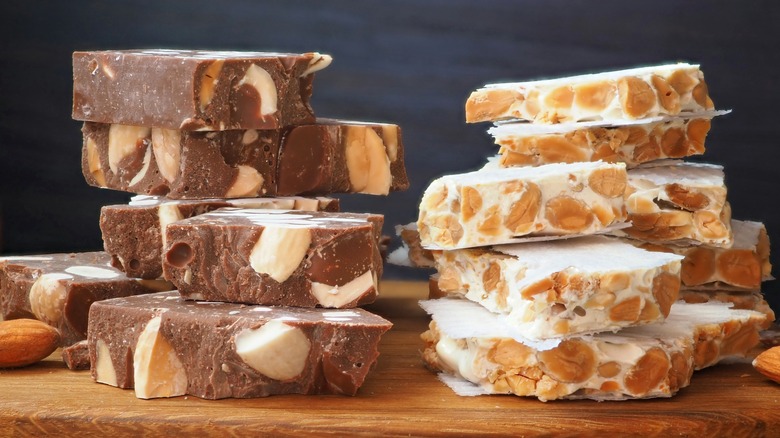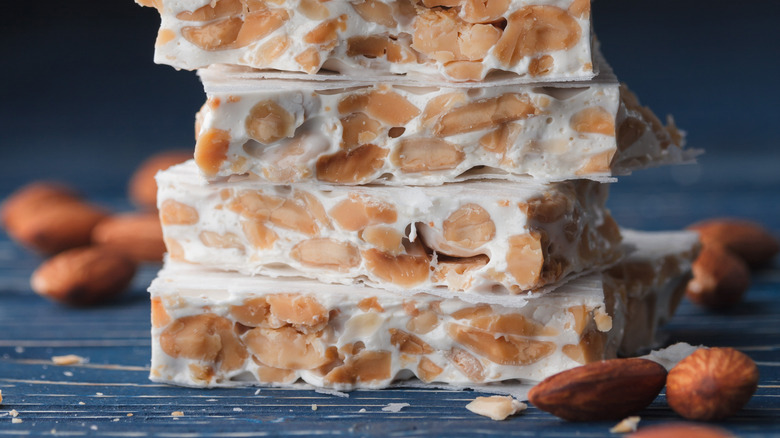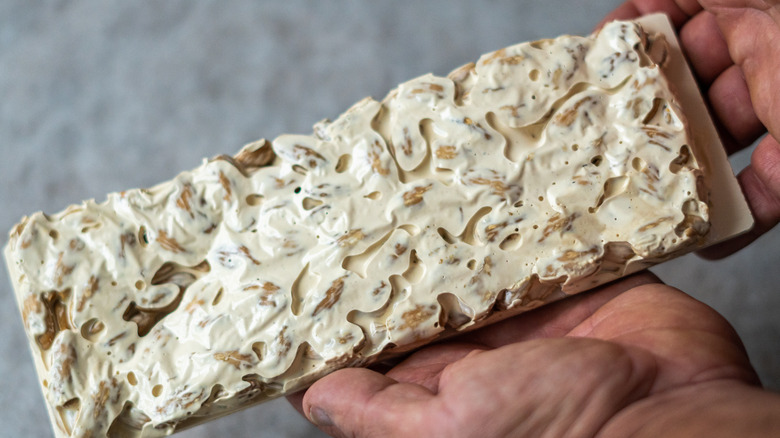Turrón: The Classic Spanish Dessert With Moorish Origins
Just like Black Forest cake is practically synonymous with Germany, turrón is synonymous with Spain. Turrón, typically considered a Christmas dish, is a nougat-style dessert that's traditionally made of honey, roasted nuts, egg whites, and sugar, giving it a sweet and nutty flavor. Generally speaking, families who have passed down the dish from generation to generation possess their own unique, respective takes on a turrón recipe. Variations can include mixing in different nuts, adding chocolate, and/or playing around with texture.
Although turrón is typically thought of as a Spanish dessert, its origins actually lie with the Moors, a term that was historically often used by Europeans to define Arabic-speaking North African Muslims. Hundreds of years ago, the Moors, who led conquests into the Iberian Peninsula, also brought this dessert to Spain, and it's thanks to them that it's taken off as such a popular treat. Here's what else to know about the history of Spanish turrón, as well as how to make a batch yourself!
The story behind Spanish turrón
Per National Geographic, the origins of turrón date back to as early as 711 C.E., when the Moors invaded the Iberian Peninsula, and ultimately reigned for roughly 800 years. As a result, people in the region adopted recipes and other cultural traditions, with North African influence running deep within the culture. One of those influences, of course, includes making and eating turrón.
While we know that the Moors occupied Spain very early on, the first written record of turrón appears around the 11th century in a Moorish document outlining how to make the treat. Originally, turrón was made with honey, but during the 1500s, the Spanish invaded South America and learned to cultivate sugar. Since then, sugar has been added to the mix, making for an even sweeter dessert. Today, the treat comes in two different varieties — Alicante (or hard) turrón and Jijona (or soft) turrón. Both of these versions continue to be enjoyed throughout Spain, and the country exports a lot of the dessert around the world, too.
Making turrón at home and other Moorish meals to know about
Because it's often imported, turrón can be a bit pricey to purchase at the supermarket. Luckily, it's fairly easy to make this recipe at home. To get started, you'll need a little more than ½ cup of honey, 1 cup of sugar, 1 egg white, and 1 ¾ cups of blanched almonds. Toast the almonds in the oven until they're golden brown, and then over medium heat, mix the honey and sugar until it reaches 240 degrees Fahrenheit. After that, beat the egg whites, add them to the mixture, and cook for another 30 minutes. Stir in your almonds and then pour the nougat onto a baking sheet lined with wafer paper to let it harden.
Turrón isn't the only North African-influenced Spanish dish that you can try to make, either. The Moors actually had a great influence on several other common Spanish recipes. For one thing, the Moors are credited with introducing almonds to Spain by way of planting groves, almonds being a key ingredient in the aforementioned turrón. But as The Olive Press tells us, they also led to the creation of other almond-based desserts, such as polvorones, a type of Christmas cookie also popular in Mexico. Other recipes that have seen Moorish influence include the popular paella. Paella, as with many other Spanish recipes, contains saffron, an ingredient that the Moors brought with them to the region.


